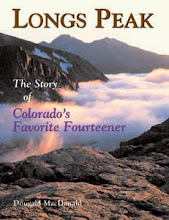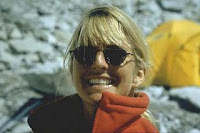
 It's a nasty week in the mountain world, as two dramas are playing out with all-too-possible lethal results. On Mt. Hood, searchers are still struggling through violent storms to search for three climbers who did not return from a summit attempt last weekend. The weather on Hood is apocalyptic this week, but hopes are kept alive for at least one of the climbers, who phoned from a snow cave near the summit on Sunday and who apparently has been switching his phone on and off since then. Meanwhile, Christine Boskoff and Charlie Fowler are overdue from a two-month expedtion to central China. The two climbers, among the most experienced mountaineers in the U.S., were due to fly to Denver on December 4. There's information on how to contribute to the search effort here, and Alpinist has done a good report on the search.
It's a nasty week in the mountain world, as two dramas are playing out with all-too-possible lethal results. On Mt. Hood, searchers are still struggling through violent storms to search for three climbers who did not return from a summit attempt last weekend. The weather on Hood is apocalyptic this week, but hopes are kept alive for at least one of the climbers, who phoned from a snow cave near the summit on Sunday and who apparently has been switching his phone on and off since then. Meanwhile, Christine Boskoff and Charlie Fowler are overdue from a two-month expedtion to central China. The two climbers, among the most experienced mountaineers in the U.S., were due to fly to Denver on December 4. There's information on how to contribute to the search effort here, and Alpinist has done a good report on the search.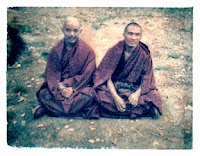
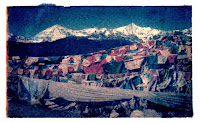 I remain perhaps irrationally optimistic in both cases. The climbers on Hood were experienced and, despite media reports to the contrary, reasonably prepared for the route; the fact that at least one of them was dug into a snow cave is a good sign. And Fowler has been doing walkabouts in China and Tibet for more than a decade—he rarely applies for permission or tells people exactly where he's going. He knows these little-explored mountains perhaps better than any Westerner, and has expressed his deep empathy for them and for the Tibetan people in evocative photographs like these Polaroid transfers from Kham, the area where he and Boskoff were traveling this fall, reproduced from Fowler's web site. Charlie is also a survivor of the first order, including walking (or crawling) away from a 400-foot fall off Longs Peak and a 1,000-foot fall in Asia. And so I am hopeful that he and Boskoff either saw something good and just decided to extend their trip and go for it, or that they ran into some trouble but soon will be walking back into a village in China, hungry and exhausted, with yet another amazing tale to tell.
I remain perhaps irrationally optimistic in both cases. The climbers on Hood were experienced and, despite media reports to the contrary, reasonably prepared for the route; the fact that at least one of them was dug into a snow cave is a good sign. And Fowler has been doing walkabouts in China and Tibet for more than a decade—he rarely applies for permission or tells people exactly where he's going. He knows these little-explored mountains perhaps better than any Westerner, and has expressed his deep empathy for them and for the Tibetan people in evocative photographs like these Polaroid transfers from Kham, the area where he and Boskoff were traveling this fall, reproduced from Fowler's web site. Charlie is also a survivor of the first order, including walking (or crawling) away from a 400-foot fall off Longs Peak and a 1,000-foot fall in Asia. And so I am hopeful that he and Boskoff either saw something good and just decided to extend their trip and go for it, or that they ran into some trouble but soon will be walking back into a village in China, hungry and exhausted, with yet another amazing tale to tell.
Friday, December 15, 2006
Hoping for the Best
Posted by
Dougald MacDonald
at
8:54 AM
3
comments
![]()
![]()
Tuesday, December 12, 2006
No Olympics for Ski Mountaineering
The IOC has decided not to include ski mountaineering in the 2014 Winter Olympics. For years now, the International Ski Mountaineering Council has been angling for an Olympic berth for the up-and-down ski races, which were part of the very first Winter Games. In the U.S., meanwhile, the sport is growing fast. The U.S. Ski Mountaineering Association just announced its schedule, with six races all over North America. And national champion Pete Swenson is organizing a new series in Colorado that will bring the sport closer to the Front Range and expose it to tens of thousands more skiers. Who knows where the Olympics will be in 2018, but sooner or later ski mountaineering still looks like a good bet to return to the Games.
Posted by
Dougald MacDonald
at
6:02 AM
0
comments
![]()
![]()
Monday, December 11, 2006
Splat Calculator
 This one's been around for a while, but it was new to me. The Splat Calculator was created by a climber named Dave Anderson, a professor of computer sciences at Carnegie Mellon. Or else he stole it from a 6th-grader named Parsingh who developed it for a science fair. Either way, it's a good Monday Morning Time Waster. Enter the height of a fall, and the Splat Calculator will tell you how soon you'll hit the ground and how fast you'll be going upon impact.
This one's been around for a while, but it was new to me. The Splat Calculator was created by a climber named Dave Anderson, a professor of computer sciences at Carnegie Mellon. Or else he stole it from a 6th-grader named Parsingh who developed it for a science fair. Either way, it's a good Monday Morning Time Waster. Enter the height of a fall, and the Splat Calculator will tell you how soon you'll hit the ground and how fast you'll be going upon impact.
Thus, when I was dropped precisely 9 meters from just below the ceiling of the Boulder Rock Club, I fell for 1.3552618543578767 seconds and was traveling 47.8 kph (29.7 mph) when I hit the pads. Wind resistance and the effect of my flapping arms probably throw off Anderson's calculations, but you get the idea. I remember having enough time in the air to look down, notice a bunch of holds scattered on the floor below me for route-setting, and think, "Oh, #@%&#!, I'm going to break my ankle." Instead, I rolled backward and smacked my head against a milk crate full of holds, slicing open my scalp (8 stitches) and causing a bloody mess and some wide-eyed horror among the middle-school students taking a class on the other side of the gym.
It's amazing how much thinking you can get done in 1.3552618543578767 seconds, which makes it all the more horrifying to consider a fall from, say, the top of the Nose of El Cap. The distance from there to the pines below is about 850 meters. Plunge time = 13.17 seconds. It's actually going to be quite a lot longer than that, because Anderson's formula doesn't take into account the atmospheric drag that would slow an El Cap diver nearly to terminal velocity. Either way, it's plenty of time to contemplate what's about to happen.
Posted by
Dougald MacDonald
at
6:40 AM
1 comments
![]()
![]()
Friday, December 08, 2006
Arno's Way
 A few weeks ago, my wife, Chris, and a friend took a couple of classes with Arno Ilgner, who tours the country these days doing his Warrior's Way mental-training programs for climbers. I went along to the second session, at Shelf Road, as belay slave. Chris had signed up because she was frustrated with her ability to lead climbs, which did not reflect her technical ability or strength. Basically, she got scared too easily.
A few weeks ago, my wife, Chris, and a friend took a couple of classes with Arno Ilgner, who tours the country these days doing his Warrior's Way mental-training programs for climbers. I went along to the second session, at Shelf Road, as belay slave. Chris had signed up because she was frustrated with her ability to lead climbs, which did not reflect her technical ability or strength. Basically, she got scared too easily.
Arno, who was one of the stronger American climbers of the late 1970s and early ’80s, has spent years studying various martial arts philosophies and relating them to rock climbing. From his handout: "The warrior philosophy derives from the uniquely demanding situation facing a soldier or combatant, such as a samurai, in a deadly duel. She must perform with absolute mastery and calm in the face of horrendous mortal danger."
OK, so bolt-clipping at Shelf Road isn't exactly "horrendous mortal danger." And Chris and Robin aren't exactly the type to embrace others' philosophies, whether it's a warrior's way or New Age touchy-feely action. They also didn't care for Arno's teaching style, which they felt relied too much on asking questions. ("Why don't you just tell us what you want us to know?" they both demanded at one point.) Given these obstacles, I wasn't sure how much Arno's clinic would help, but the results were profound.
I think the most valuable things Chris took away were some simple practices to help her maintain focus while leading. During Chris and Robin's leads, Arno repeatedly asked them, "Are you resting or are you climbing?" That is, when they stopped at a good hold, they should maximize the rest, study the route above them, and not dick around half-heartedly trying moves. Once they were ready to go, they should commit to keep moving until they reached the next rest stance. Sounds simple, but most of us don't climb that way; we're not 100% committed to either resting or climbing. He also taught them a simple practice before beginning a sequence of moves: Look up, look down, look up. Look up, to plan your sequence. Look down, to spot key footholds. Look up and, boom, start climbing. I can't explain the theory behind it, but it works.
Chris and Robin also did some whipper therapy, which they had been dreading. (Like a lot of people, they were much more comfortable falling indoors than out; both could count the number of real falls they'd taken outdoors in the last couple of years on one hand, or maybe even a couple of fingers.) Both of them shed some tears on the first route. But Arno's falling practice was much more effective than anything I'd seen or tried before. It wasn't just flinging yourself off, with the vain hope that this would somehow make you feel better. Instead, he taught them to assess dangers and compare them with past experiences; if the danger appeared to be no greater than ones they'd experienced before and survived, then there should be no problem. They practiced falling at the third bolt of a vertical climb, and at first they didn't even climb above the bolt. They'd just assume a climbing stance, and then I (the belayer) would pay out a teeny bit of slack, so they'd drop a couple of feet. Arno taught them good techniques for falling (arms spread, looking down, feet relaxed but ready, exhaling strongly), and had them focus on this as they fell. After each fall, he'd ask them for their observations, and, as the falls got bigger and bigger, their bottom-line observation became, "Hey, that wasn't too bad."
Results? It's been about three weeks, and Chris still thinks a lot about falling while she's climbing. But she has pushed herself very hard, indoors and out, on routes where she definitely might fall, and she's climbing more decisively than I've ever seen her. For now, at least, the lessons seem to be sticking. Anyway, I don't think she expected a miracle; she's just grateful for some progress. We're headed to Spain at the end of next week, and she is psyched to climb!
Posted by
Dougald MacDonald
at
7:39 AM
2
comments
![]()
![]()
Wednesday, December 06, 2006
Blogroll
 I don't see many newspaper blogs that I like, but Out There, written mostly by a few reporters from the Gazette in Colorado Springs, is a winner. Modestly subtitled "Colorado Springs' Path to the Outdoors," the blog will interest anyone who likes outdoor sports in the Centennial State. It's frequently updated, wide-ranging, and quirky: You never know what you'll find, like this rattler shot from today.
I don't see many newspaper blogs that I like, but Out There, written mostly by a few reporters from the Gazette in Colorado Springs, is a winner. Modestly subtitled "Colorado Springs' Path to the Outdoors," the blog will interest anyone who likes outdoor sports in the Centennial State. It's frequently updated, wide-ranging, and quirky: You never know what you'll find, like this rattler shot from today.
Posted by
Dougald MacDonald
at
4:20 PM
0
comments
![]()
![]()
Screaming Deal
I'm biased for the American Alpine Club: I'm a past board member, I helped hire the executive director, and I do a lot of paid work for the organization. But I can say without bias that the AAC's current membership promotion is a screaming deal. New members joining the AAC can add just $30 to their dues and get a full-year subscription to Alpinist magazine (normally $46) plus a free Black Diamond Alpine Bod harness (retail $29.95). That's $46 of savings for new AAC members. And get this: If you're 28 or under, an AAC membership is just $40. There are plenty of other good reasons to join the AAC, but if you've been thinking about getting a subscription to Alpinist or buying BD's great little harness for glacier travel, now's obviously the time.
Posted by
Dougald MacDonald
at
1:39 PM
1 comments
![]()
![]()
Tuesday, December 05, 2006
New Tool for Peeping Toms?
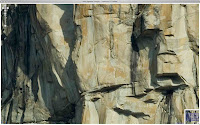
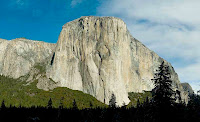 OK, class, anyone recognize this feature on El Cap? That's the Roof and Headwall of the Salathé Wall. The truly amazing thing is that this pair of photos is actually the same photo—the one on top is just a super-enlarged version of the one below it. This much detail is possible because the photo was created with an extremely high-resolution digital camera and special software. It was posted online by an outfit called xRez. You can see more Yosemite photos, panoramas from the Sierra's East Side, cool cityscapes (that's Boston in the other pair of photos), and more at the xRez site. The company says you can see climbers in some of these photos, but I couldn't find them in a tour up the Nose and Salathé routes, though I did spot a haul bag and blue bucket hanging somewhere left of the Nose; the El Cap photo was taken in winter (you can see snow on the ledges), which explains the underpopulated walls.
OK, class, anyone recognize this feature on El Cap? That's the Roof and Headwall of the Salathé Wall. The truly amazing thing is that this pair of photos is actually the same photo—the one on top is just a super-enlarged version of the one below it. This much detail is possible because the photo was created with an extremely high-resolution digital camera and special software. It was posted online by an outfit called xRez. You can see more Yosemite photos, panoramas from the Sierra's East Side, cool cityscapes (that's Boston in the other pair of photos), and more at the xRez site. The company says you can see climbers in some of these photos, but I couldn't find them in a tour up the Nose and Salathé routes, though I did spot a haul bag and blue bucket hanging somewhere left of the Nose; the El Cap photo was taken in winter (you can see snow on the ledges), which explains the underpopulated walls.
 How do they do it? The xRez site says: "The equipment required to shoot spherical panoramic imagery has typically been the use of a simple panoramic nodal head, which is manually turned to dozens of preset shooting positions, covering every possible angle within a sphere of the camera. Gigapixel level work, however, requires many hundreds of shots to be taken and demands the use of an automated motion control head which has the precision (and patience) to execute the large amount of overlapping images. The resulting shots are then stitched together in dedicated software, often taking many days of uninterrupted processing for a single image to be assembled."
How do they do it? The xRez site says: "The equipment required to shoot spherical panoramic imagery has typically been the use of a simple panoramic nodal head, which is manually turned to dozens of preset shooting positions, covering every possible angle within a sphere of the camera. Gigapixel level work, however, requires many hundreds of shots to be taken and demands the use of an automated motion control head which has the precision (and patience) to execute the large amount of overlapping images. The resulting shots are then stitched together in dedicated software, often taking many days of uninterrupted processing for a single image to be assembled."
I don't know what most of that means, but the results are stunning. xRez clearly isn't in this biz to provide better beta to climbers. They're aiming at big-dollar markets like Hollywood and Madison Avenue. Meanwhile, the samples they've put up are gaperific. There's a mind-blowing Zion landscape "coming soon" to the site, so it will be well-worth checking back.
Posted by
Dougald MacDonald
at
6:21 AM
0
comments
![]()
![]()
Monday, December 04, 2006
The Mallorca Hype
 Now that Chris Sharma has repeated another 5.15a climb, in Spain, the hype masters are again trotting out the "fact" that Sharma's deep-water solo route in Mallorca, climbed in late September, is at least 5.15a and may be 5.15b. The web site 8a.nu suggested 5.15b for the Mallorca climb, based on Sharma's 100 attempts over six visits before completing the route. (He needed fewer than 20 tries to redpoint the 5.15a La Rambla in Spain last week.) Rock & Ice said (on the cover) that Sharma's new route "is arguably the hardest climb ever done, and could reshape the sport as we know it." Inside, R&I said it's "likely the hardest rock climb in the world." Climbing said it was "a contender for the hardest single pitch in the world."
Now that Chris Sharma has repeated another 5.15a climb, in Spain, the hype masters are again trotting out the "fact" that Sharma's deep-water solo route in Mallorca, climbed in late September, is at least 5.15a and may be 5.15b. The web site 8a.nu suggested 5.15b for the Mallorca climb, based on Sharma's 100 attempts over six visits before completing the route. (He needed fewer than 20 tries to redpoint the 5.15a La Rambla in Spain last week.) Rock & Ice said (on the cover) that Sharma's new route "is arguably the hardest climb ever done, and could reshape the sport as we know it." Inside, R&I said it's "likely the hardest rock climb in the world." Climbing said it was "a contender for the hardest single pitch in the world."
The famously reticent Sharma said that his new route, shown here in a Miguel Riera photo from Desnivel, felt harder than anything he'd ever done before, even harder than his 2001 5.15a Realization. But there's a world of difference between deep-water soloing and rehearsing a route with a rope and then redpointing it. With a rope, you can stop at each bolt and carefully work out the moves and sequences for as long as you want. In deep-water soloing, you get one shot at a crux move and then you're in the drink, and you have to start over from the bottom. In this way, deep-water soloing is a beautiful return to the past traditions of ground-up ascents. As Sharma said in Climbing, deep-water soloing is "pure." But put the same route on dry land, with a bolt every six feet, and it's extremely unlikely that it would still feel as difficult.
Just because someone solos a climb doesn't mean it deserves a harder rating. A 5.12 is still 5.12, whether it's rehearsed a billion times on toprope, soloed onsight, or climbed naked with a watermelon hanging off one's harness (Charley Bentley, Vitamin H, Rifle). Sharma is obviously one of the world's best rock climbers, and it's a magnificent achievement to succeed on such a desperate climb without a rope. Sharma's experience of climbing that enormous arch in Mallorca may indeed have been his hardest and most meaningful yet. But it's just silly to suggest the arch is therefore the hardest route in the world.
Posted by
Dougald MacDonald
at
7:00 AM
3
comments
![]()
![]()
Sunday, December 03, 2006
Google for Runners
 Back when I was a serious runner (my one-year fling with ultras in 2004-05), someone turned me on to this terrific tool for measuring routes on Google Maps. I'm suprised how many people still don't know about the Gmap "pedometer," which is great for accurately measuring the distance of running routes, such as this favorite, the Doudy Draw loop near Boulder. The tool works best on roads and highly visible trails (like bike paths in the prairie), and not so well on heavily forested trails. But I just noticed that the guy who built this thing has added a topo map overlay, which, though slow, greatly improves Gmap's usefulness for trail runners and hikers. Google Earth does this, too (Tools > Rule > Path), but I think Gmap is a simpler and more effective tool for route mapping.
Back when I was a serious runner (my one-year fling with ultras in 2004-05), someone turned me on to this terrific tool for measuring routes on Google Maps. I'm suprised how many people still don't know about the Gmap "pedometer," which is great for accurately measuring the distance of running routes, such as this favorite, the Doudy Draw loop near Boulder. The tool works best on roads and highly visible trails (like bike paths in the prairie), and not so well on heavily forested trails. But I just noticed that the guy who built this thing has added a topo map overlay, which, though slow, greatly improves Gmap's usefulness for trail runners and hikers. Google Earth does this, too (Tools > Rule > Path), but I think Gmap is a simpler and more effective tool for route mapping.
Marathoners and ultrarunners say you're supposed to plan workouts by time and effort, not by distance, but it's still fun to know exactly how far you went. This tool tells you down to the ten-thousandth of a mile—a little over 6 inches.
Posted by
Dougald MacDonald
at
7:47 AM
0
comments
![]()
![]()




